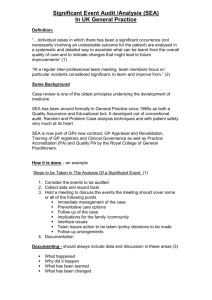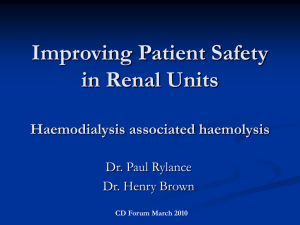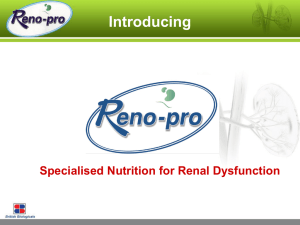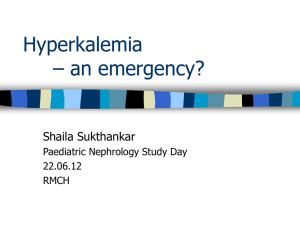results from the Renal Association Patient Safety Project
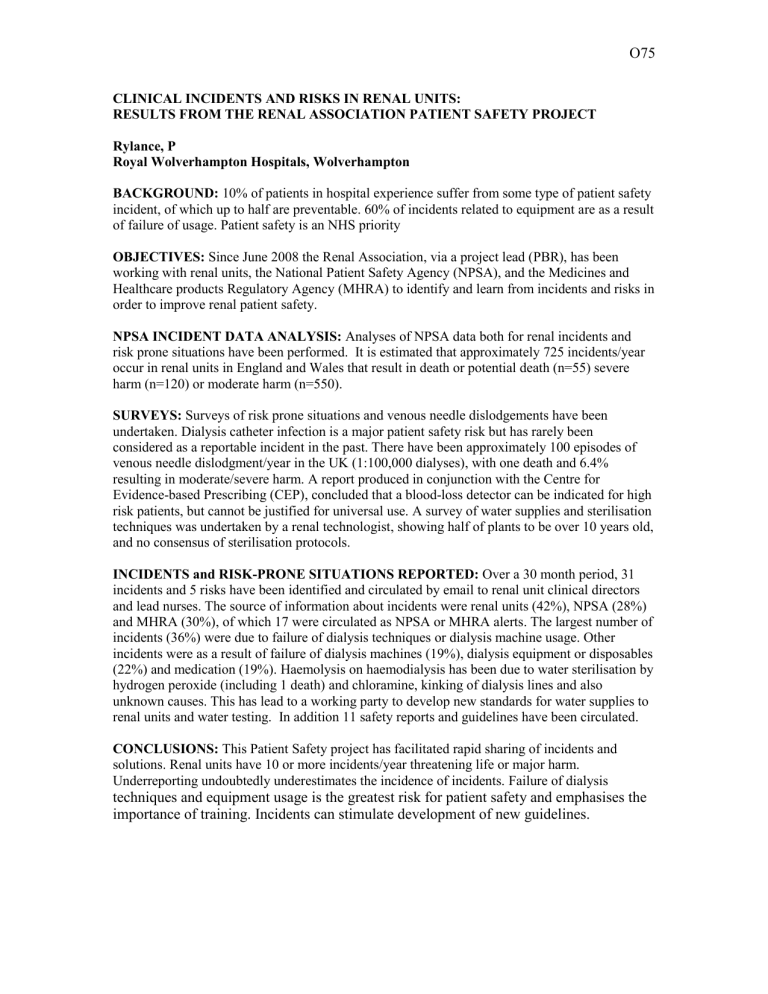
O75
CLINICAL INCIDENTS AND RISKS IN RENAL UNITS:
RESULTS FROM THE RENAL ASSOCIATION PATIENT SAFETY PROJECT
Rylance, P
Royal Wolverhampton Hospitals, Wolverhampton
BACKGROUND: 10% of patients in hospital experience suffer from some type of patient safety incident, of which up to half are preventable. 60% of incidents related to equipment are as a result of failure of usage. Patient safety is an NHS priority
OBJECTIVES: Since June 2008 the Renal Association, via a project lead (PBR), has been working with renal units, the National Patient Safety Agency (NPSA), and the Medicines and
Healthcare products Regulatory Agency (MHRA) to identify and learn from incidents and risks in order to improve renal patient safety.
NPSA INCIDENT DATA ANALYSIS: Analyses of NPSA data both for renal incidents and risk prone situations have been performed. It is estimated that approximately 725 incidents/year occur in renal units in England and Wales that result in death or potential death (n=55) severe harm (n=120) or moderate harm (n=550).
SURVEYS: Surveys of risk prone situations and venous needle dislodgements have been undertaken. Dialysis catheter infection is a major patient safety risk but has rarely been considered as a reportable incident in the past. There have been approximately 100 episodes of venous needle dislodgment/year in the UK (1:100,000 dialyses), with one death and 6.4% resulting in moderate/severe harm. A report produced in conjunction with the Centre for
Evidence-based Prescribing (CEP), concluded that a blood-loss detector can be indicated for high risk patients, but cannot be justified for universal use. A survey of water supplies and sterilisation techniques was undertaken by a renal technologist, showing half of plants to be over 10 years old, and no consensus of sterilisation protocols.
INCIDENTS and RISK-PRONE SITUATIONS REPORTED: Over a 30 month period, 31 incidents and 5 risks have been identified and circulated by email to renal unit clinical directors and lead nurses. The source of information about incidents were renal units (42%), NPSA (28%) and MHRA (30%), of which 17 were circulated as NPSA or MHRA alerts. The largest number of incidents (36%) were due to failure of dialysis techniques or dialysis machine usage. Other incidents were as a result of failure of dialysis machines (19%), dialysis equipment or disposables
(22%) and medication (19%). Haemolysis on haemodialysis has been due to water sterilisation by hydrogen peroxide (including 1 death) and chloramine, kinking of dialysis lines and also unknown causes. This has lead to a working party to develop new standards for water supplies to renal units and water testing. In addition 11 safety reports and guidelines have been circulated.
CONCLUSIONS: This Patient Safety project has facilitated rapid sharing of incidents and solutions. Renal units have 10 or more incidents/year threatening life or major harm.
Underreporting undoubtedly underestimates the incidence of incidents. Failure of dialysis


